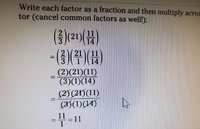RobertB1985
New member
- Joined
- Jun 14, 2021
- Messages
- 5
Hi all,
First time here and I'm learning calculus for 1st time.
This problem doesn't seem like calculus to me, but it is a test question in a calulus textbook.
Question:
(2/3)(21) (11/14)=?
3rd step of problem is:
(2)(21)(11)
----------- =
(3)(1)(14)
What I can't figure out is WHY the textbook crosses out the:2,3,21,and 14??
Leaving 11/1 .
I agree with the answer. I need to understand the cancellation.
Thanks a ton,
Robert
First time here and I'm learning calculus for 1st time.
This problem doesn't seem like calculus to me, but it is a test question in a calulus textbook.
Question:
(2/3)(21) (11/14)=?
3rd step of problem is:
(2)(21)(11)
----------- =
(3)(1)(14)
What I can't figure out is WHY the textbook crosses out the:2,3,21,and 14??
Leaving 11/1 .
I agree with the answer. I need to understand the cancellation.
Thanks a ton,
Robert

